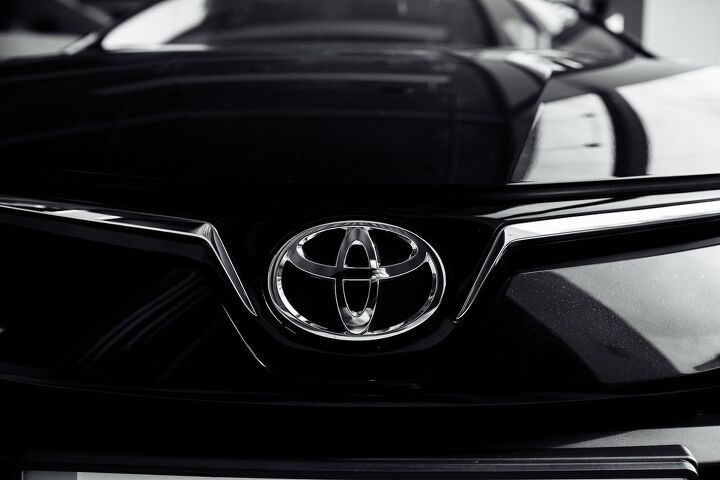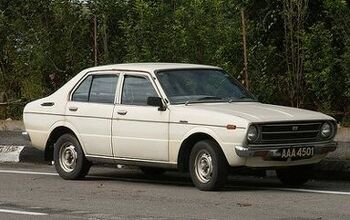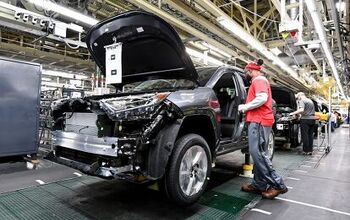Will Toyota's Production Pause Go Global?

Following last week’s announcement where Toyota explained its need to scale back Japanese production by 20 percent this April, the automaker has outlined planned slowdowns for the foreseeable future. It’s citing all the usual problems. Countries are still employing various COVID-19 restrictions that are upending supply chains, semiconductor production for automobiles remains insufficient, and there’s a war in Eastern Europe that’s creating all-new troubles while exacerbating some of the more familiar ones. But scaling back output might not be the death sentence it sounds like.
With last year resulting in 10 million deliveries worldwide, Toyota actually managed to improve its sales against 2020’s year-over-year global production decline of 12 percent. And the last two years have also yielded enhanced profitability for the automaker, despite it having expressed repeated concerns about procuring enough components to keep popular models (like the RAV4) in stock. In 2021, Toyota saw $249.4 billion in revenue and even became the best-selling automaker in the United States, dethroning former top-dawg General Motors.
In fact, there is a coalition of automakers that have started suggesting that it might be more lucrative to scale back output, reduce overhead, and focus on achieving broader margins per car. Though this isn’t necessarily true for all markets. While automakers have been trying to suss out how to tweak the business for Western markets, most have continued bolstering volume in China (which is viewed as a growth region). We just saw Volkswagen announce its intention to prioritize assembly in Asia for that very reason. But Toyota has likewise seen better sales growth in China than in other parts of the world.
That’s not to suggest China doesn’t pose some problems, however. When Toyota announced plans to scale back production in Japan, Chinese suppliers that had to be shut down due to ongoing pandemic restrictions were said to have played a relevant factor. Though its talk on launching planned reductions were left vague and focused on the bigger picture, which the company would remain uncertain.
“In addition to the shortage of semiconductors, the spread of COVID-19 and other factors are making it difficult to look several months ahead, and there is a possibility that the production plan may be lower,” the company explained. “However, we will continue to closely examine the situation of parts supply and suppliers, and make every effort to reduce the scope of sudden production cuts as much as possible, to normalize the production plan, and to reduce the burden on suppliers.”
From Toyota:
Under these circumstances and in light of a review of past developments, we have revised production plans to be more reasonable in line with recent realities. Specifically, we have positioned the three-month period from April to June as an “intentional pause,” and we will create plans based on the personnel structures and facility capacities of suppliers. By doing this, we will establish healthy workplace environments that place the highest priority on safety and quality, rather than exceeding the capacities of facilities, pushing people to their limits, and making do through overtime work. We will then inform our suppliers of plans that incorporate production reduction risks and other factors up to three months in advance, review production plans on a monthly and three-monthly basis, and share these plans with our suppliers.
Based on the above, our global production plan for April including overseas production is approximately 750,000 units (250,000 units in Japan and 500,000 units overseas). Although the number of units we provided to our suppliers at the beginning of the year includes recovery from previous production cutbacks, due to the impact of semiconductor shortages, we have adjusted our production plan by approximately 150,000 units globally. The global production plan average from April through June is around 800,000 units.
Thus far, those reductions will only be targeting Japanese facilities — specifically the Tsutsumi, Tahara, Kyushu-Miyata, Iwate, and Fujimatsu Plants. But the company has stated on more than one occasion that additional cuts could be forthcoming and there are credible rumors suggesting there’s already a plan for slowdowns at facilities located in other countries, should the existing cuts be deemed insufficient. Considering how often Toyota’s release mentions global output, those rumors should probably not be discounted.
Though, even if Toyota’s output remains totally unchanged in other regions, there will still be ramifications for North America. Despite the overwhelming majority of its lineup being produced locally, its luxury arm still has a bevy of models that have to be shipped in from Japan. While Lexus has the RX and ES are produced in Ontario and Kentucky, respectively, other models have to be imported from the aforementioned Miyata and Tahara plants.
“We would also like to extend our sincere apologies once again to those customers who have been waiting for vehicles to be delivered,” the company stated. “By normalizing the production environment, we hope to deliver vehicles with high quality as many as possible. We continue to make every effort with concerned parties such as production, procurement, and sales.”
[Image: Andrii Medvediuk/Shutterstock]

A staunch consumer advocate tracking industry trends and regulation. Before joining TTAC, Matt spent a decade working for marketing and research firms based in NYC. Clients included several of the world’s largest automakers, global tire brands, and aftermarket part suppliers. Dissatisfied with the corporate world and resentful of having to wear suits everyday, he pivoted to writing about cars. Since then, that man has become an ardent supporter of the right-to-repair movement, been interviewed on the auto industry by national radio broadcasts, driven more rental cars than anyone ever should, participated in amateur rallying events, and received the requisite minimum training as sanctioned by the SCCA. Handy with a wrench, Matt grew up surrounded by Detroit auto workers and managed to get a pizza delivery job before he was legally eligible. He later found himself driving box trucks through Manhattan, guaranteeing future sympathy for actual truckers. He continues to conduct research pertaining to the automotive sector as an independent contractor and has since moved back to his native Michigan, closer to where the cars are born. A contrarian, Matt claims to prefer understeer — stating that front and all-wheel drive vehicles cater best to his driving style.
More by Matt Posky
Latest Car Reviews
Read moreLatest Product Reviews
Read moreRecent Comments
- Peter I want a self driving red ragtop 1958 Plymouth Fury. Just like the car in the movie Christine.
- Mgh57 Doesn't seem like this tech is ready for prime time.
- Nathan The Ram is the most boring looking of the full size trucks, kind of like a Tundra.If they cancel the Ram Classic, I hope a full resign makes the Ram at least look interesting.
- DJB1 I'll be all for it when it has a proven safety record. I have an awesome life and a lot to live for, so right now I'm not putting that in the hands of overconfident tech-bros.
- Mgh57 I had to read the article because I had had no idea what the headline meant. I've never seen this in the Northeast. Don't understand the point. Doesn't seen efficient aerodynamically


































Comments
Join the conversation
Meanwhile Hyundai is ramping up US inventory. While the others are taking advantage of the supply chain "crisis" to increase their per vehicle profit, Hyundai is taking advantage of them to increase their market share. Never thought I'd says this, but my next vehicle might be a Hyundai. Well, maybe not... Hyundai dealers are taking advantage of the current state of affairs to set a dealer markup that's thousands of dollars more than other dealers. Bad time to buy cars.
ads what ads? get Brave browser